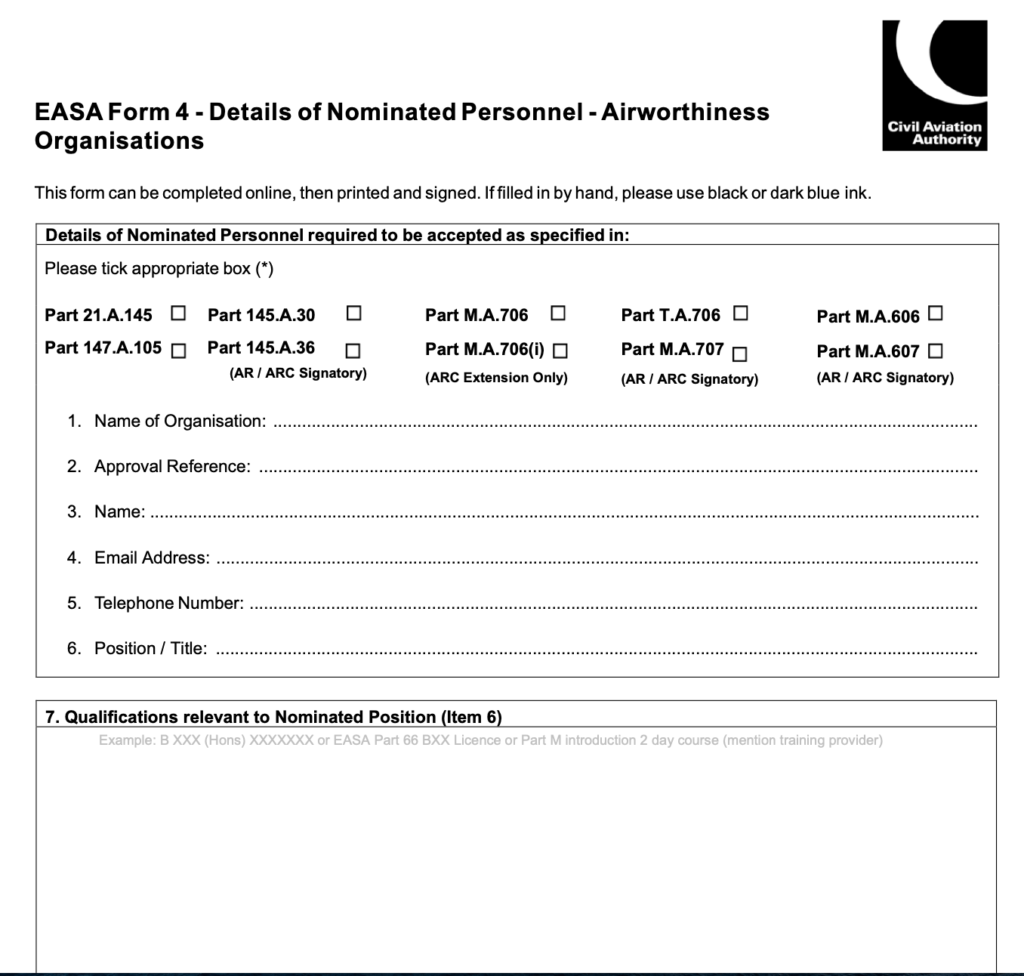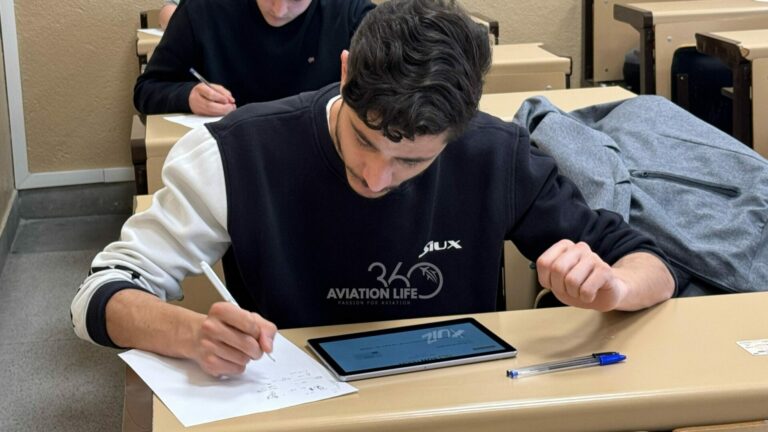Since you start in the aeronautical maintenance profession, the main objective is to obtain an aeronautical maintenance license that allows certifying maintenance tasks performed on the aircraft, but what steps must be followed to do so?
What is the procedure to follow to obtain a European Aeronautical Maintenance license?
In order to successfully apply for an aeronautical maintenance license, you will need to meet the EASA Part 66 requirements for basic knowledge and basic experience requirements.
Knowledge requirements for obtaining an EASA Part 66 Aeronautical Maintenance License
The basic knowledge requirements refer to exams/modules that must be passed integrality with a result superior to 75% of correct answers, such exams will be of the multiple choice type with three answers of which only one is correct. Three of these exams/modules M7, M9, and M10 will have two essay questions each, in case of passing the multiple-choice part and failing the developmental part only the failed part will be examined. The validity of the exams is 10 years from the date of the first exam passed.
The exams to be taken vary according to the category of license you wish to obtain, as you can see below.
To learn about the different license categories in aeronautical maintenance read my previous post where I describe each category.
For a B1.1 license, the following must be passed:
- Module 1 Mathematics
- Module 2 Physics
- Module 3 Fundamentals of Electricity
- Module 4 Fundamentals of Electronics
- Module 5 Digital Techniques/Electronic Instrument Systems
- Module 6 Materials, equipment and tools
- Module 7A Maintenance Practices
- Module 8 Basic Aerodynamics
- Module 9A Human Factors
- Module 10 Aviation Legislation
- Module 11A Aerodynamics, structures and systems
- Module 15 Gas Turbine Engines
- Module 17A Propellers
For a B1.3 license, the following must be passed:
- Module 1 Mathematics
- Module 2 Physics
- Module 3 Fundamentals of Electricity
- Module 4 Fundamentals of Electronics
- Module 5 Digital Techniques/Electronic Instrument Systems
- Module 6 Materials, equipment and tools
- Module 7A Maintenance Practices
- Module 8 Basic Aerodynamics
- Module 9A Human Factors
- Module 10 Aviation Legislation
- Module 12 Helicopter Aerodynamics, Structures and Systems
- Module 15 Gas Turbine Engines
For a B2 License you must pass:
- Module 1 Mathematics
- Module 2 Physics
- Module 3 Fundamentals of Electricity
- Module 4 Fundamentals of Electronics
- Module 5 Digital Techniques/Electronic Instrument Systems
- Module 6 Materials, equipment and tools
- Module 7A Maintenance Practices
- Module 8 Basic Aerodynamics
- Module 9A Human Factors
- Module 10 Aviation Legislation
- Module 13 Aircraft Aerodynamics, Structures and Systems
- Module 14 Propulsion
It should be noted that modules 2, 6 and 7 of Category B1 have a higher level than the equivalents for category B2. In category B2, modules 4, 5 and 7.4 (General avionics test equipment) have a higher level than the equivalent modules in category B1.
If you wish to take the B1.1 and B2 exams, you must take the exams at the highest level.
If you have a license of one category, e.g. B1.1, and you wish to obtain another category, e.g. B2, you will have to take the difference exams, see below.
- Category B1.1 to Category B2, examinations to be performed 4, 5, 7.4, 13, 14.
- Category B1.1 to Category B1.3, exams to be taken 12.
- Category B1.3 to Category B1.1, examinations to be performed 11A, 17.
- Category B1.3 to Category B2, examinations to be performed 4, 5, 7.4, 13, 14.
- Category B2 to Category B1.1, examinations to be performed 2, 6, 7, 11A, 15, 17.
- Category B2 to Category B1.3, examinations to be performed 2, 6, 7, 12, 15.
Basic experience requirements for an EASA Part 66 maintenance license
The basic experience requirements will vary depending on the aeronautical training you have completed, e.g. for a B1 or B2 license.
If aeronautical maintenance studies have been completed in an EASA 147 certified center, the basic experience requirement will be 2 years.
If aeronautical maintenance studies have been carried out in a non-EASA-certified center, but the competent authority of the country of application recognizes such center as valid, the basic experience requirement will be 3 years.
In the case of not having completed any training in aeronautical maintenance, it will be necessary to demonstrate a basic experience of at least 5 years.
What happens if I pass the studies in a Center 147 but not all the modules?
If you have completed your studies in an EASA 147 approved center and passed all theory and practical exams, but you have not passed all modules/exams required by Part-66 to apply for a maintenance license and for personal reasons you end up passing a different EASA 147 approved center for example.
Having completed and passed a course of Aeronautical Maintenance EASA 147 B1.3 at the CEFAAL institute in Albacete (Spain) certified ES.147.015 but unfortunately not having passed all the modules/exams of Part 66, the student ends up passing the rest of the modules at the CITHE center in Madrid (Spain) certified EASA 147.004.
Following the above example for AESA (Spanish Aviation Safety Agency) the student does not have sufficient requirements to apply for a maintenance license after two years of demonstrable experience, even if he/she has attended and completed an approved EASA 147 course. Therefore, I would only be entitled to apply after 3 years of experience since EASA does recognize training as relevant.
According to consultation number 19079, case number 3In this case, the student is entitled to apply for a maintenance license after the required two years of experience, since he/she must pass the entire training in a 147 center.
The basic experience must be performed in an EASA 145 certified center, on civil and operational aircraft. During the time required as minimum experience, the technician must make a record of the work performed. Depending on the country of application, the content of the registration may vary.
What is a basic experience log or Log Book?
The basic experience record or Log Book is a record of the maintenance tasks performed throughout the professional career. The possession of an updated Log book is a prerequisite to apply for an aeronautical maintenance license. It will be vital when looking for a job as it demonstrates the professional experience gained. As you can see the Log Book is a fundamental piece in the professional career of the aeronautical maintenance technician, so from the moment you start performing maintenance tasks you should record the tasks performed in the basic experience log.
How to fill out Basic Experience Log / Log Book for Aviation Maintenance
The basic experience record or Log Book must contain the Aircraft Registration, Aircraft Type, ATA chapter, AMM, brief description of the task, task number, date of completion and Signature/Stamp of the supervisor certifying the task. The certifier’s signature section will be required depending on the country where it is applied, here you will find two examples;


So it is highly recommended to obtain the certifier’s signature when performing the maintenance task. In case of obtaining the certifier’s signature, be sure to ask for their license number and if possible request their certificate of authorization as a certifier from the quality department.
In the task section, it is essential to cover all applicable ATA chapters according to the license category applied.
Depending on the country where it is applied, the minimum number of tasks to be performed per month may vary from 12 to 17 tasks to be considered a month.
It is advisable not to put more than one task per day since many authorities will not take these tasks into consideration, it is better to distribute them over a whole month covering as much time as possible.
As a final point to the Basic Experience Record, the final signature of the head of the quality department or the person in charge of maintenance of the company for which the work has been done will be required. If it will be applied in a country other than where the basic experience record has been made, a copy of the EASA Form 4 certificate of the person responsible for the quality or maintenance department that has certified the experience must be requested, so that the competent authority can verify the ability of that person to certify basic experience records, for example.
Work at Tarmac Aerosave FR.145.0627 (Tarbes, France) and apply for a maintenance license in Spain.

In the case of having worked in multiple companies, a basic experience record must be made for each company, signed by the quality or maintenance managers of each company. The signature must be made in the labor registration section (Certificate by…), and a copy of the EASA 145 certificate of the company where you have worked must also be requested. Examples


Here you can download the Basic Experience Book required/log book by AESA.
Advice to take into account before applying for the aeronautical maintenance license
A personal tip, make certified copies of all important experience records and certificates to send to the competent authority. The experience record is, together with the maintenance license and type certificates, the most important documentation of an aeronautical technician.
In case the company you work for has the capacity to apply for a maintenance license on your behalf, it will make this bureaucratic process easier and less stressful, but if you apply on your own you will have to review all the documents before submitting them so that you don’t miss anything.
As you can see, applying for an aeronautical maintenance license is not a simple process, but it will mark a before and after in your professional career. You should not lose hope, it is a matter of effort and perseverance.
I hope this article is helpful, if you have any other questions please leave me a comment. Much strength.





